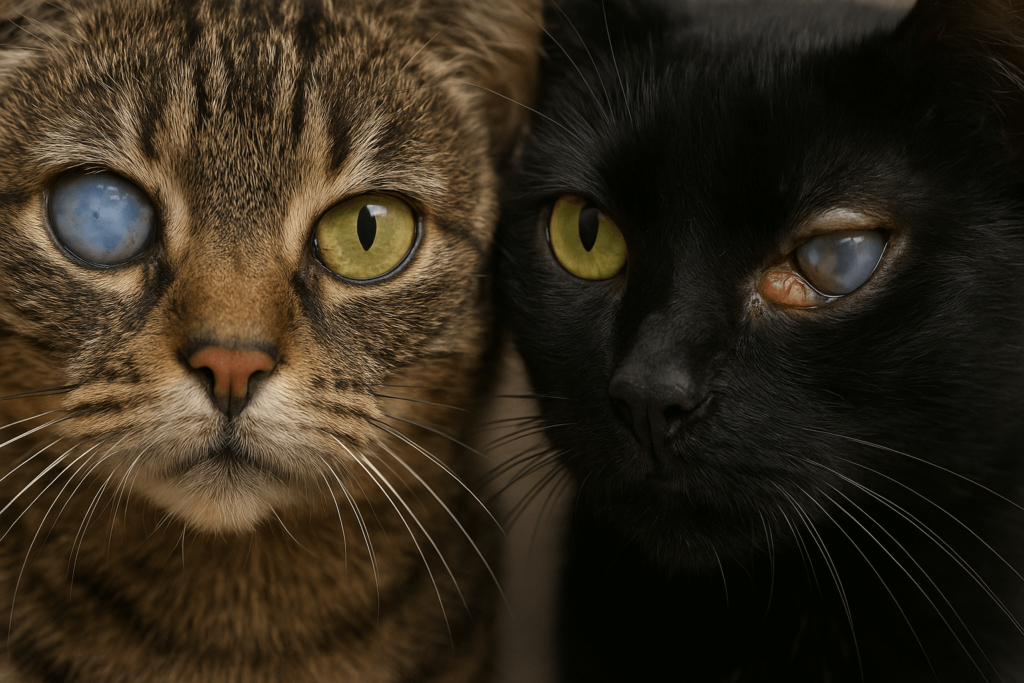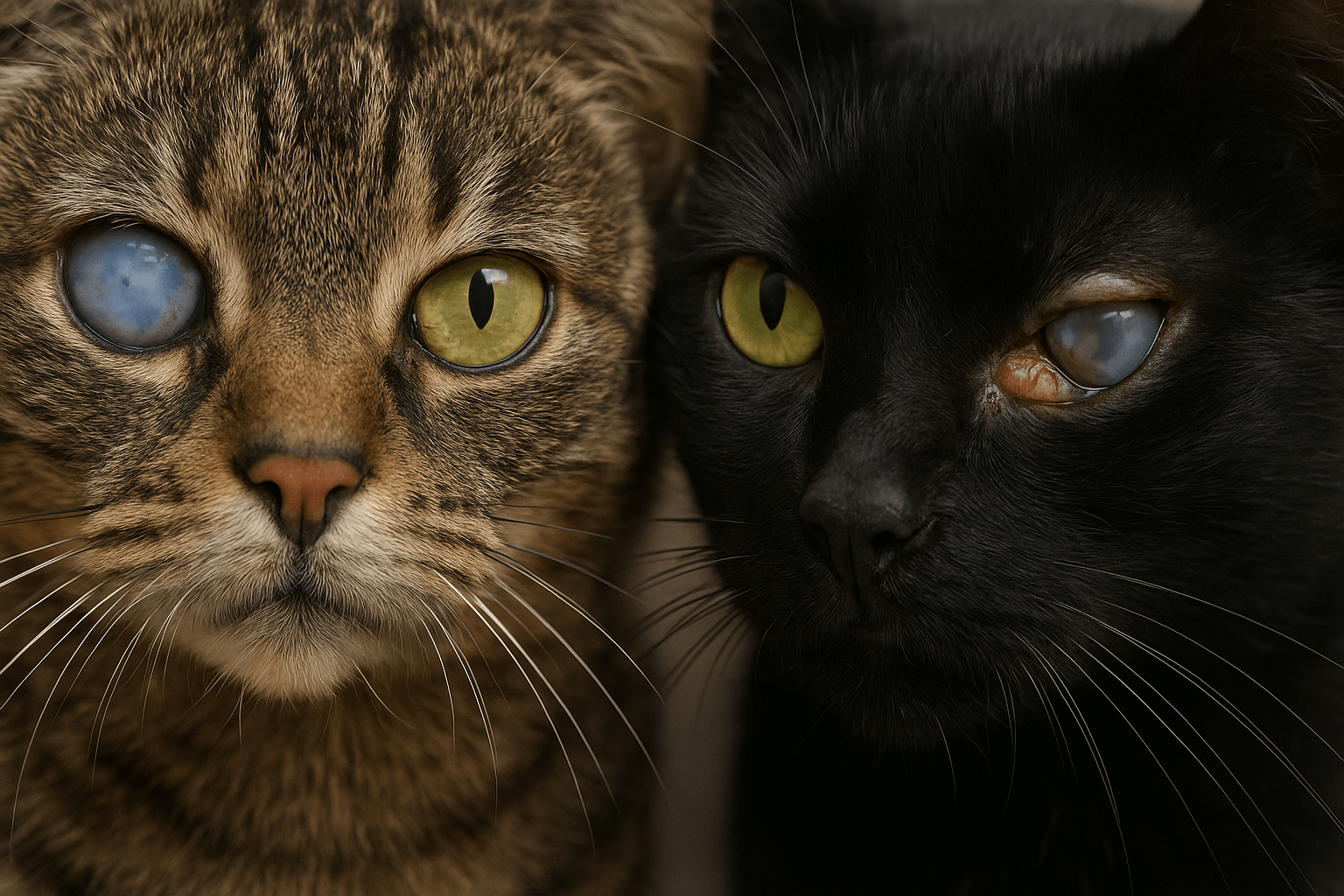Cat Eye Diseases: Understanding and Protecting Your Feline’s Vision
A cat’s eyes are not only strikingly beautiful but also essential for their survival and well-being. However, like humans, cats are susceptible to a variety of eye diseases that can affect their vision and overall health. From minor irritations to serious conditions requiring immediate veterinary attention, understanding these ailments is crucial for every cat owner. Early detection and proper care can make all the difference in preserving your feline friend’s precious sight. In this guide, we’ll explore common cat eye diseases, their symptoms, prevention tips, and treatment options to help you keep your cat’s eyes healthy and bright.
Common Cat Eye Diseases and Their Symptoms
Recognizing the signs of eye diseases early can prevent complications and ensure timely treatment. Here are some of the most common conditions that affect cats’ eyes and what to look out for.
Conjunctivitis (Pink Eye):
This inflammation of the eye lining causes redness, swelling, and discharge. Cats may squint or rub their eyes frequently.Corneal Ulcers:
Often caused by trauma or infections, corneal ulcers lead to cloudiness, tearing, and sensitivity to light. Untreated ulcers can result in vision loss.Glaucoma:
Increased pressure within the eye can cause bulging, pain, and blindness. Early signs include dilated pupils and a cloudy appearance.Uveitis:
Inflammation of the uvea (middle layer of the eye) results in redness, squinting, and excessive tearing. It may indicate an underlying systemic issue.Cataracts:
Cloudy areas in the lens impair vision and may develop due to aging, diabetes, or genetics. Cataracts often appear as a milky haze over the pupil.
Understanding these symptoms allows you to act quickly if your cat shows signs of discomfort or visual impairment, ensuring they receive the care they need.

Preventative Measures to Protect Your Cat’s Eyes
Prevention is key to maintaining your cat’s eye health and reducing the risk of diseases. These proactive steps can help safeguard their vision.
Regular Veterinary Check-Ups:
Schedule routine eye exams to catch potential issues early and ensure your cat’s eyes remain healthy.Keep Their Environment Clean:
Dust, allergens, and debris can irritate your cat’s eyes. Regular cleaning of their living space minimizes exposure to harmful particles.Monitor Playtime and Outdoor Activities:
Supervise interactions with other animals and outdoor exploration to prevent injuries that could damage their eyes.Provide a Balanced Diet:
Nutrient-rich food supports overall health, including eye function. Look for diets rich in antioxidants like vitamins A and E.Avoid Exposure to Harsh Chemicals:
Keep cleaning products and sprays away from your cat to prevent accidental irritation or burns.
By incorporating these preventative measures into your daily routine, you can significantly reduce the likelihood of eye problems in your feline companion.
Check this guide 👉Understanding Cat Eye Language: Best 7 Expert Tips!
Check this guide 👉Cat Eye Irritation: Best 7 Expert Tips!
Check this guide 👉Understanding Cat Eye Cataracts: Best 7 Expert Tips!
Preventative Tips for Cat Eye Health | Signs of Potential Eye Problems |
|---|---|
Schedule regular vet check-ups | Redness or swelling around the eyes |
Maintain a clean living environment | Excessive tearing or discharge |
Supervise outdoor activities | Squinting or pawing at the eyes |
Feed a nutrient-rich diet | Cloudiness or changes in eye appearance |
Avoid harsh chemicals | Sensitivity to light or behavioral changes |
Treatment Options for Common Cat Eye Diseases
If your cat develops an eye condition, prompt treatment is vital to prevent further complications. Here are some common approaches veterinarians may recommend based on the diagnosis.
Antibiotics for Bacterial Infections:
Medications like ointments or drops are prescribed to treat infections such as conjunctivitis or uveitis.Anti-Inflammatory Drugs:
Steroids or non-steroidal medications reduce inflammation and alleviate pain associated with conditions like uveitis.Surgical Intervention for Severe Cases:
Procedures may be necessary for advanced issues like glaucoma or deep corneal ulcers to preserve vision.Laser Therapy for Cataracts:
While not always curative, laser treatments can improve clarity and slow cataract progression in some cases.Pain Management and Supportive Care:
Pain relief medications and supportive therapies ensure your cat remains comfortable during recovery.
With proper treatment and care, many eye diseases can be managed effectively, allowing your cat to live a happy, healthy life.
When to Seek Immediate Veterinary Attention
Some eye conditions require urgent care to prevent permanent damage or worsening symptoms. Knowing when to consult a vet is critical for your cat’s well-being.
Sudden Vision Loss:
If your cat appears disoriented or unable to navigate familiar spaces, seek help immediately.Severe Swelling or Bulging Eyes:
Rapid changes in eye shape or size can indicate glaucoma or trauma, both of which need swift intervention.Persistent Discharge or Bleeding:
Yellow, green, or bloody discharge signals infection or injury that requires professional treatment.Behavioral Changes Related to Eyes:
Hiding, lethargy, or excessive vocalization may point to discomfort or pain linked to eye issues.Foreign Objects Stuck in the Eye:
Never attempt to remove objects yourself—seek veterinary assistance to avoid causing further harm.
Acting quickly in these situations can save your cat’s vision and prevent long-term complications.
Signs Your Cat May Be Experiencing Eye Pain
Eye pain can manifest in subtle ways, making it important to observe your cat closely. Look for these behavioral and physical indicators that something might be wrong.
Excessive Blinking or Squinting:
Cats often blink or squint to shield painful or irritated eyes from light and movement.Rubbing Their Face Against Objects:
This behavior is an attempt to relieve discomfort by applying pressure to the affected area.Holding One Eye Closed:
Keeping one eye shut indicates localized pain or sensitivity in that specific eye.Changes in Pupil Size:
Uneven or unusually dilated pupils may reflect underlying pain or neurological issues.Increased Aggression or Withdrawal:
Painful cats may become unusually aggressive or hide more than usual to avoid interaction.
Identifying these signs early ensures your cat receives the care they need before the condition worsens.
The Role of Nutrition in Eye Health
Proper nutrition plays a significant role in maintaining your cat’s eye health. Certain nutrients support vision and protect against degenerative conditions.
Vitamin A for Retinal Health:
Essential for night vision, vitamin A deficiency can lead to dry eyes and corneal issues.Taurine for Overall Eye Function:
This amino acid is crucial for preventing retinal degeneration and maintaining healthy vision.Omega-3 Fatty Acids for Inflammation Reduction:
Found in fish oil, omega-3s reduce inflammation and promote tear production.Antioxidants Like Vitamin E and C:
These combat free radicals that contribute to age-related eye diseases such as cataracts.Zinc for Immune Support:
Zinc aids in enzyme function and helps maintain the structural integrity of the eye.
Incorporating these nutrients into your cat’s diet fosters long-term eye health and vitality.
Home Remedies vs. Professional Care
While home remedies can sometimes provide temporary relief, they should never replace professional veterinary care. Here’s how to balance the two approaches responsibly.
Saline Solution for Mild Irritation:
A sterile saline rinse can flush out minor debris or allergens, but it won’t treat infections or serious conditions.Warm Compresses for Swelling:
Applying a warm, damp cloth to swollen areas reduces inflammation temporarily but doesn’t address root causes.Limiting Screen Time for Recovery:
Restricting access to bright lights or screens gives irritated eyes time to heal naturally.Avoid Over-the-Counter Human Medications:
Products like Visine or Neosporin can harm cats and should only be used under veterinary guidance.Know When to Call the Vet:
Persistent symptoms, worsening conditions, or unexplained behaviors always warrant professional evaluation.
Balancing home care with expert advice ensures your cat receives comprehensive support for their eye health.
Frequently Asked Questions About Cat Eye Diseases
What causes eye infections in cats?
Bacteria, viruses, fungi, or environmental irritants can trigger eye infections in cats.
Can indoor cats get eye diseases?
Yes, indoor cats are still prone to conditions like conjunctivitis, cataracts, or injuries from household hazards.
How can I clean my cat’s eyes safely?
Use a damp, lint-free cloth and gently wipe away dirt or discharge without applying pressure.
Are certain breeds more prone to eye problems?
Flat-faced breeds like Persians are more susceptible to eye issues due to their facial structure.
Is blindness common in older cats?
While age-related conditions like cataracts or glaucoma can lead to blindness, many older cats maintain good vision with proper care.
Prioritizing Your Cat’s Eye Health
Your cat’s eyes are windows to their soul—and to their overall health. By staying informed about common eye diseases, recognizing symptoms early, and taking preventative measures, you can protect your feline friend’s vision and quality of life. Remember, even minor changes in your cat’s eyes warrant attention, as they could signal underlying issues. With vigilance, compassion, and timely veterinary care, you can ensure your cat enjoys a lifetime of clear, healthy vision.
Cat Fever Treatment: Best 7 Expert Tips! Discover expert advice on identifying, managing, and treating fever in cats to ensure their quick recovery and well-being.
Understanding Meloxicam for Cats: Best 7 Expert Tips! Learn how to safely administer meloxicam, manage side effects, and ensure your cat's comfort with expert advice on feline pain relief.
Amoxicillin for Cat UTI: Best 7 Expert Tips! Discover safe usage, dosage guidelines, and expert advice on treating feline urinary tract infections effectively with amoxicillin.
Understanding Cat Cancer Treatment: Best 7 Expert Tips! Discover expert advice on managing feline cancer, from early detection to treatment options, ensuring your cat’s health and comfort.





